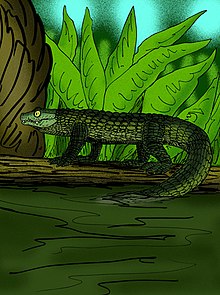Mekosuchinae
| Mekosuchinae | |
|---|---|

| |
| Life restoration of Mekosuchus inexpectatus | |
| Scientific classification | |
| Domain: | Eukaryota |
| Kingdom: | Animalia |
| Phylum: | Chordata |
| Class: | Reptilia |
| Clade: | Archosauromorpha |
| Clade: | Archosauriformes |
| Order: | Crocodilia |
| Clade: | †Mekosuchinae Willis, Molnar & Scanlon, 1993 |
| Type species | |
| †Mekosuchus inexpectatus Balouet & Buffetaut, 1987
| |
| Genera | |
Mekosuchinae is an extinct subfamily of crocodylids from Australia and the South Pacific. They first appear in the fossil record in the Eocene in Australia, and survived until the arrival of humans: in the Pleistocene in Australia and within the Holocene in the Pacific islands of Fiji, New Caledonia and Vanuatu. There is however disagreement on whether or not Mekosuchinae is a true subfamily within Crocodylidae, or a distinct crocodilian family in its own right, Mekosuchidae, within the superfamily Crocodyloidea.
Mekosuchine crocodiles are a diverse group. One of the last species, Mekosuchus inexpectatus from Holocene New Caledonia, may have been arboreal.[1] The early Miocene species, Harpacochampsa camfieldensis, may have resembled a false gharial. Another mekosuchine fossil, currently undescribed, has been found in Miocene deposits from New Zealand. One genus, Mekosuchus, managed to spread to the islands of the Pacific; it is believed to have island-hopped across the Coral Sea, moving first to a now submerged island known as Greater Chesterfield Island, then New Caledonia and onwards.
In the Pleistocene, Quinkana was one of the top terrestrial predators of the Australian continent.
Mekosuchines underwent a drastic decline in post-Miocene Australia, with all genera, except for Quinkana and Pallimnarchus (both perishing during the Quaternary extinction event) becoming expirated or extinct in Australia by the end of the Pliocene. After the demise of Quinkana and Pallimnarchus, the group survived on Vanuatu and New Caledonia until the arrival of humans, who are presumed to have driven them to extinction.
References
- ^ Naish, Darren (13 May 2009). "The small, recently extinct, island-dwelling crocodilians of the south Pacific". Tetrapod Zoology. ScienceBlogs. Retrieved 27 November 2010.
- Mead, J. I.; Steadman, D. W.; Bedford, S. H.; Bell, C. J.; Spriggs, M. (August 2002). Guyer, C. (ed.). "New extinct mekosuchine crocodile from Vanuatu, South Pacific". Copeia. 3 (3): 632–641. doi:10.1643/0045-8511(2002)002[0632:NEMCFV]2.0.CO;2.



